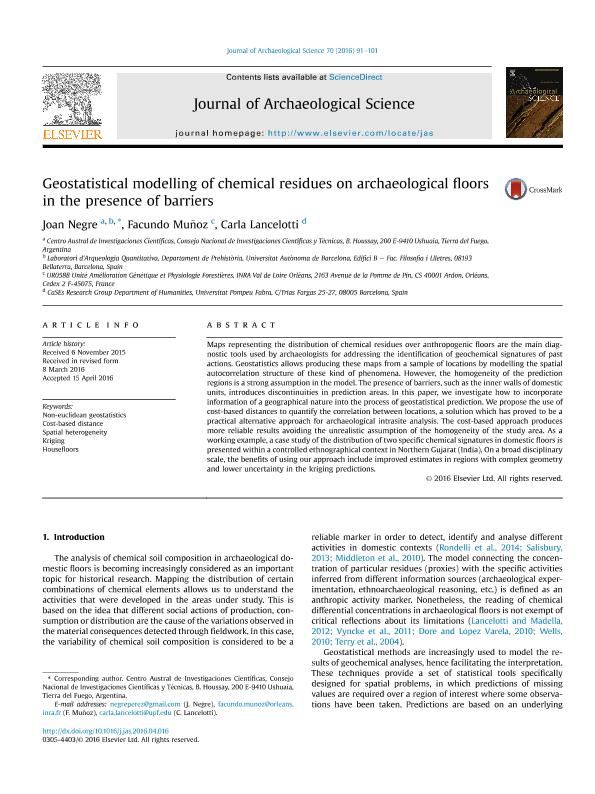Mostrar el registro sencillo del ítem
dc.contributor.author
Negre Pérez, Joan

dc.contributor.author
Muñoz, Facundo
dc.contributor.author
Lancelotti, Carla
dc.date.available
2020-01-14T20:51:09Z
dc.date.issued
2016-06
dc.identifier.citation
Negre Pérez, Joan; Muñoz, Facundo; Lancelotti, Carla; Geostatistical modelling of chemical residues on archaeological floors in the presence of barriers; Academic Press Ltd - Elsevier Science Ltd; Journal of Archaeological Science; 70; 6-2016; 91-101
dc.identifier.issn
0305-4403
dc.identifier.uri
http://hdl.handle.net/11336/94700
dc.description.abstract
Maps representing the distribution of chemical residues over anthropogenic floors are the main diagnostic tools used by archaeologists for addressing the identification of geochemical signatures of past actions. Geostatistics allows producing these maps from a sample of locations by modelling the spatial autocorrelation structure of these kind of phenomena. However, the homogeneity of the prediction regions is a strong assumption in the model. The presence of barriers, such as the inner walls of domestic units, introduces discontinuities in prediction areas. In this paper, we investigate how to incorporate information of a geographical nature into the process of geostatistical prediction. We propose the use of cost-based distances to quantify the correlation between locations, a solution which has proved to be a practical alternative approach for archaeological intrasite analysis. The cost-based approach produces more reliable results avoiding the unrealistic assumption of the homogeneity of the study area. As a working example, a case study of the distribution of two specific chemical signatures in domestic floors is presented within a controlled ethnographical context in Northern Gujarat (India). On a broad disciplinary scale, the benefits of using our approach include improved estimates in regions with complex geometry and lower uncertainty in the kriging predictions.
dc.format
application/pdf
dc.language.iso
eng
dc.publisher
Academic Press Ltd - Elsevier Science Ltd

dc.rights
info:eu-repo/semantics/openAccess
dc.rights.uri
https://creativecommons.org/licenses/by-nc-sa/2.5/ar/
dc.subject
COST-BASED DISTANCE
dc.subject
HOUSEFLOORS
dc.subject
KRIGING
dc.subject
NON-EUCLIDEAN GEOSTATISTICS
dc.subject
SPATIAL HETEROGENEITY
dc.subject.classification
Arqueología

dc.subject.classification
Historia y Arqueología

dc.subject.classification
HUMANIDADES

dc.subject.classification
Química Analítica

dc.subject.classification
Ciencias Químicas

dc.subject.classification
CIENCIAS NATURALES Y EXACTAS

dc.subject.classification
Estadística y Probabilidad

dc.subject.classification
Matemáticas

dc.subject.classification
CIENCIAS NATURALES Y EXACTAS

dc.title
Geostatistical modelling of chemical residues on archaeological floors in the presence of barriers
dc.type
info:eu-repo/semantics/article
dc.type
info:ar-repo/semantics/artículo
dc.type
info:eu-repo/semantics/publishedVersion
dc.date.updated
2020-01-13T14:23:50Z
dc.journal.volume
70
dc.journal.pagination
91-101
dc.journal.pais
Países Bajos

dc.journal.ciudad
Amsterdam
dc.description.fil
Fil: Negre Pérez, Joan. Consejo Nacional de Investigaciones Científicas y Técnicas. Centro Austral de Investigaciones Científicas; Argentina. Universitat Autònoma de Barcelona; España
dc.description.fil
Fil: Muñoz, Facundo. Institut National de la Recherche Agronomique; Francia
dc.description.fil
Fil: Lancelotti, Carla. Universitat Pompeu Fabra; España
dc.journal.title
Journal of Archaeological Science

dc.relation.alternativeid
info:eu-repo/semantics/altIdentifier/doi/http://dx.doi.org/10.1016/j.jas.2016.04.016
dc.relation.alternativeid
info:eu-repo/semantics/altIdentifier/url/https://www.sciencedirect.com/science/article/pii/S0305440316300255
Archivos asociados
